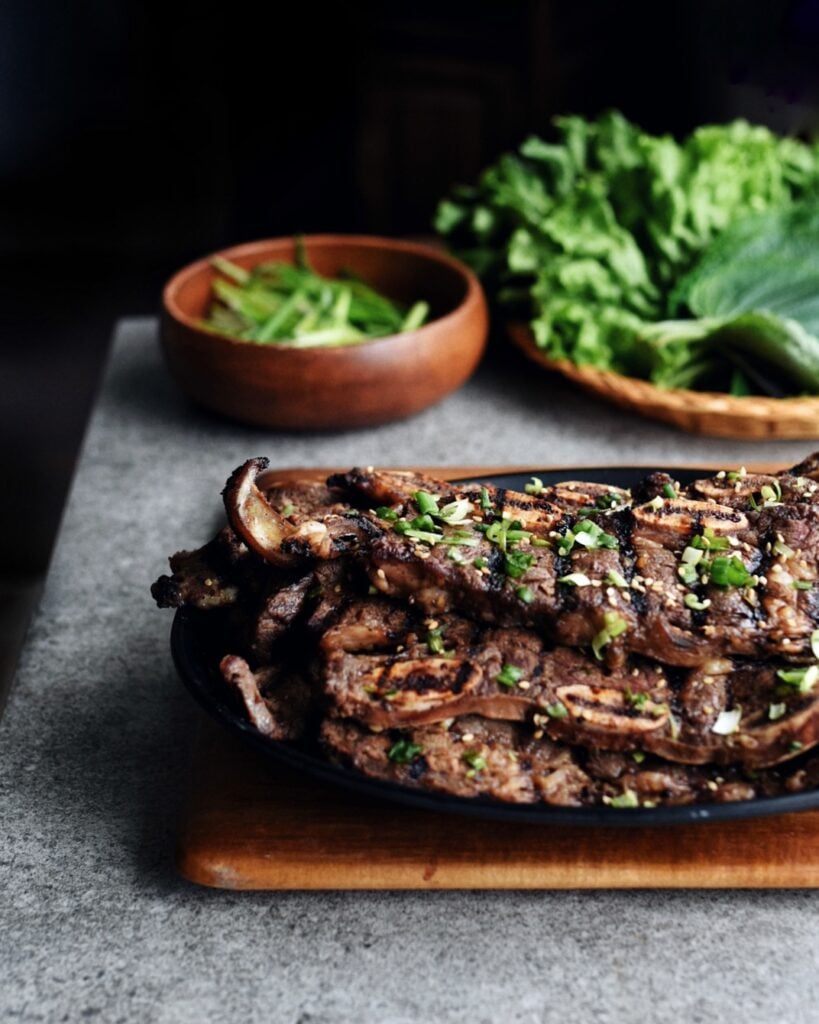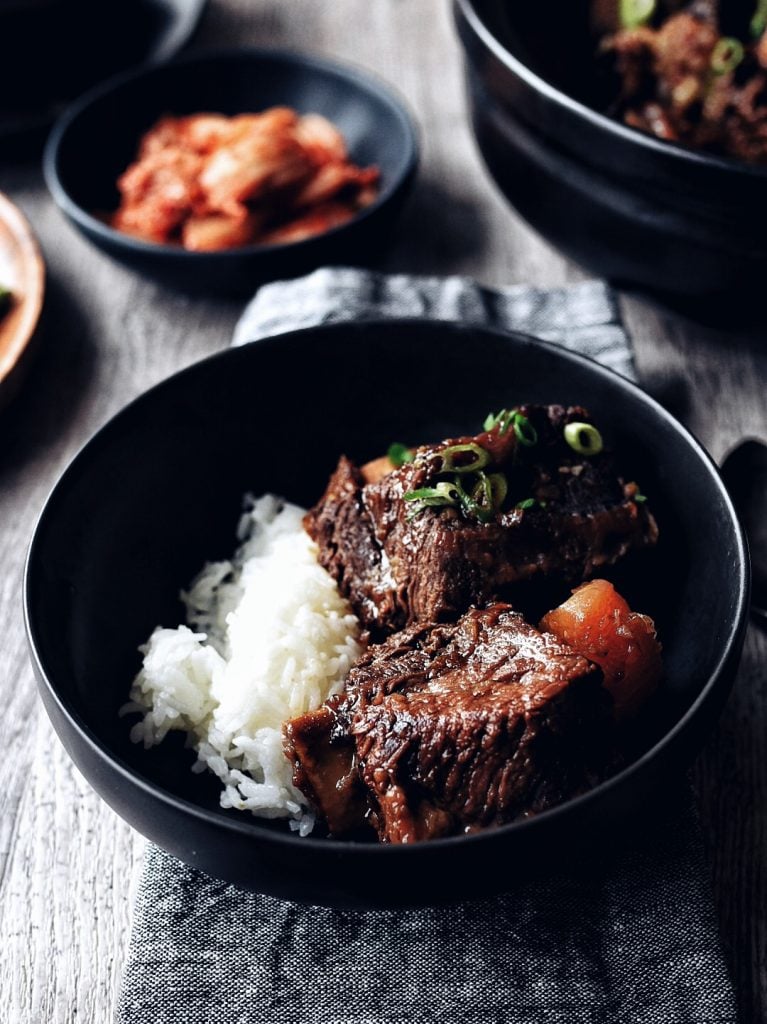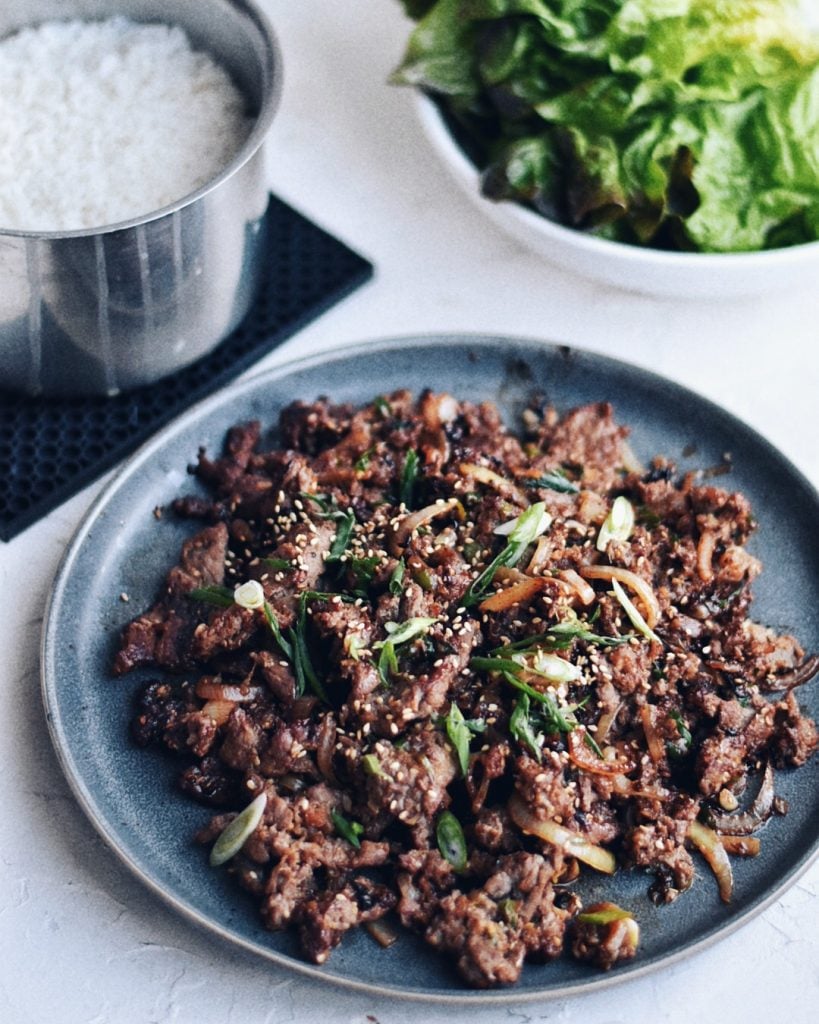Beef Bulgogi Stainless Steel or Non Stick Youtube
Korean Beef Bulgogi

Everybody loves Korean Beef Bulgogi. A sizzling plate of this Korean classic deserves a regular place in your dinner rotation!

There's a reason why everyone loves Korean Beef Bulgogi. Fast, tasty, and on the table in 30 minutes. You'll be wondering why you never made it before!
I grew up loving and eating this iconic dish. Korean Beef Bulgogi was a staple at barbecues and a special treat for weeknight dinner. Now my kids love it just as much as I do. As a bonus, leftovers taste great for school lunch the next day. (I put bulgogi in a thermos over rice, sometimes with a fried egg on top.)
What is Bulgogi?
Bulgogi is the catch-all Korean term for thinly sliced, marinated meat that's cooked over a flame. Bulgogi literally translates, "Fire Meat."
The flavors are usually salty + sweet with plenty of garlic and green onion. But spicy bulgogi, marinated with Gochujang (fermented chili paste) and Gochukaru (dried chili flakes), are also commonly cooked.
The key characteristics of bulgogi: thinly sliced meat, marinated before cooking, and cooked over high heat.
Some of my favorites:
- Spicy Pork Belly Bulgogi
- Ground Beef Bulgogi Bowls
- Osam Bulgogi [Squid + Pork Belly]
- Chicken Bulgogi
What's the difference between Bulgogi and Galbi?
Bulgogi and Galbi are made with different cuts of meats.
Bulgogi generally refers to thinly sliced meat. Bulgogi is much faster to cook and very weeknight friendly — because of the thin cut meat.
Galbi generally refers to meat that's attached to a bone, which takes longer to cook. Galbi means "bone" in Korean. Galbi is usually thicker, meatier, and more rich and indulgent.
Think long-braised, stewed dishes like Galbi Jjim [Beef Short Ribs] and Spicy Galbi Jjim [Babyback Pork Ribs]. But Galbi also can mean LA Galbi which is Korean BBQ short ribs.
-

LA Galbi (bbq beef short ribs) -

Galbi Jjim (beef short ribs) -

Spicy Galbi Jjim (pork ribs)
How do I cook Bulgogi?
Bulgogi is cooked over high heat. It doesn't really matter how you cook it, as long as it's hot!
Some ways to cook Bulgogi at home:
- Cook in non-stick skillet
- Sear in a wok, cast iron pan, or stainless steel skillet
- Broil on high heat in the oven
- Sizzle in a grill pan in the middle of the table (with butane-style burner, like the kind used in hot pot)
Typically, Koreans use a non-stick skillet for Bulgogi. But if you prefer charred, smoky bits of meat, I recommend a wok, cast iron pan, or stainless steel skillet.
But I've also broiled on high heat in the oven, on a foil-lined sheet pan. Fast and easy, this is a good way to cook a double or triple portion of bulgogi for a party.
Also, Korean Beef Bulgogi is not a dry meat dish. As you cook, the meat will release its juices. Save those juices and scrape into your serving platter. There's nothing so good as bulgogi juice spooned on top of rice!

How do I eat Korean Beef Bulgogi?
There are many ways to enjoy Korean Beef Bulgogi. Be as creative as you dare!
- Serve with rice and steamed green vegetables
- In a rice bowl with fried egg and Gochujang sauce!
- Korean BBQ style with lettuce wraps, kimchi, and Ssamjang
- Wrapped in Gimbap, Onigirazu, or even burritos!
- Tossed on top of tator tots with kimchi and Cheese Whiz
- Stuffed into Bahn Mi with pickled daikon and carrot
What kind of meat should I use for Korean Beef Bulgogi?
For this recipe, I recommend thinly sliced rib eye. Thinly sliced rib eye is weeknight friendly because it takes very little time to marinate. Also, it cooks up fast!
Most Asian grocers carry this cut of meat, either in the refrigerated section or the freezer section. If there's only frozen rib eye available (the kind used for hot pot), then defrost overnight before using.

What's in the marinade?
The marinade ingredients are staples in my Korean American Pantry: onion, garlic, sugar, soy sauce, ginger, sesame oil, green onions.
Simply whiz in your food processor until it looks like baby puree. Or grate with a box grater. This is the classic Korean way of marinating meat.
Note: I do not add Asian pear to my beef bulgogi marinade. Many Korean home cooks add Asian pear as a tenderizing and/or sweetening agent but the thin slices of rib eye don't require it, in my opinion. For LA Galbi and other Korean dishes, yes — I always add Asian pear. But for this recipe, I don't think it's necessary.
How to Make Korean Beef Bulgogi:
In a food processor, whizz onion, garlic, and ginger until pureed. (Alternately, you can grate the onion and mince the garlic and ginger.)

Scrape into a bowl and add sliced onion, green onion, soy sauce, rice wine, sugar, sesame oil, and sesame seeds.

Add thinly sliced beef. Mix well. Set aside to marinate for 30 minutes.

Get the cast iron pan ready. I use a 12-inch, well seasoned, cast iron pan. Heat until smoking. Add 1 Tbsp oil and swirl around. Add bulgogi in a thin layer and leave undisturbed for 3-4 minutes, to get that bbq char. When the edges are brown and crispy looking, mix around and finish cooking. The meat should release a lot of juice.

Enjoy!!


Beef Bulgogi
A sizzling plate of delicious Bulgogi deserves a regular place in your dinner rotation!
Course Dinner, Main Course
Cuisine Korean
- 1 lb thinly sliced beef rib eye
In the food processor:
- 1/2 onion cut into chunks
- 4 garlic cloves
- 1/2 inch ginger peeled and cut into chunks
In the prep bowl:
- 1/2 onion sliced thinly
- 2 green onions chopped
- 1/4 cup soy sauce (not the low sodium kind)
- 2 Tbsp sugar
- 2 Tbsp Mirin or rice wine
- 1 Tbsp sesame seed oil
- 1 Tbsp sesame seeds
-
In a food processor, combine 1/2 onion cut into chunks, garlic, and ginger. Whizz until pureed. You may have to scrape the bowl down several times during the process. (Alternately, you can grate the onion and mince the garlic and ginger.) Scrape into a large bowl.

-
Add 1/2 onion (thinly sliced), green onions, soy sauce, sugar, Mirin or rice wine, sesame seed oil, and sesame seeds. Mix with a spoon until combined.

-
Add beef and mix well with hands. Let sit at room temperature for 30 minutes.

-
Heat a well seasoned cast iron skillet over medium high heat. When the cast iron is hot, add 1 Tbsp neutral oil and swirl around in the pan. The oil should be smoking. Add bulgogi in one layer. Leave the meat undisturbed, to get that bbq char on one side. When the bulgogi looks brown and crispy on the edges, mix around with a spatula and finish cooking. The meat will release a lot of juice. The cooking process should take 5-8 minutes total!

-
Garnish bulgogi with additional green onion and sesame seeds. Serve with lettuce wraps, rice, and kimchi for a complete meal. Ssam sauce is also a nice addition.

Source: https://thesubversivetable.com/bulgogi/
0 Response to "Beef Bulgogi Stainless Steel or Non Stick Youtube"
Post a Comment